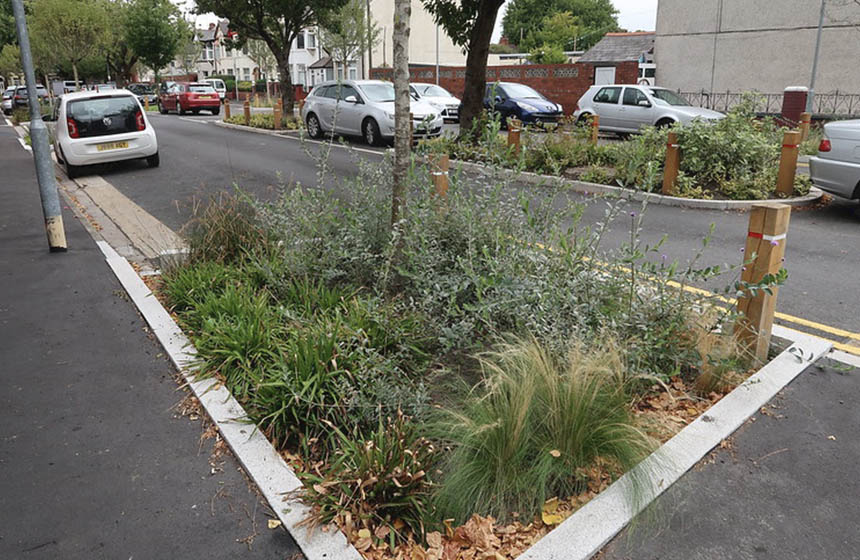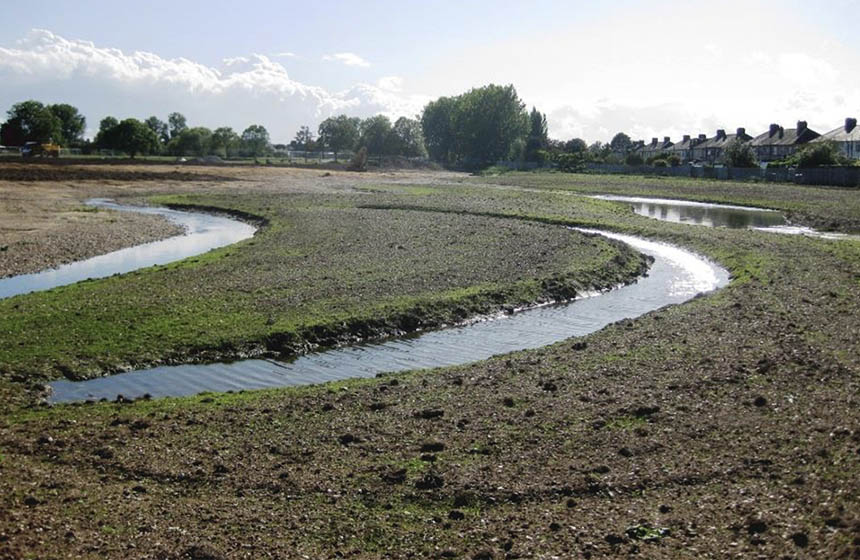Greener Grangetown SuDS project
Working with local communities to retrofit a sustainable drainage system into existing urban streets, creating over 100 raingardens while leaving space for parking and other needs.
Nature-based intervention:
Sustainable Drainage Systems (SuDS) projects mimic natural drainage to reduce the volume and flow rates of run-off in built-up areas (1). In Wales, Dŵr Cymru (Welsh Water) is implementing SuDS through their RainScape programme, creating features such as rainwater retention basins, planters, swales (long shallow landscaped channels), porous paving, filter strips, and geocellular storage (3).The SuDS project at Grangetown was initiated to decrease the volume of rainwater entering the overloaded sewage system and provide attractive green space for residents and commuters (2). To achieve this, over 100 raingardens featuring a diverse mix of native trees, shrubs and grasses were created on the streets of Grangetown to catch and filter rainwater. Pipes at the base of the raingardens collect water during heavy storms and channel the cleaned water into the River Taff. Local communities were involved from the start, to retrofit the SuDS into existing streets while minimising adverse impacts such as loss of parking spaces, and delivering extra benefits including a community garden, bike lanes, and improved safety for pedestrians and motorists. The project was the first in the UK to use these techniques at this scale, covering an area of 12 hectares that included 500 properties in 12 streets with approximately 1,150 residents (2) (4).
Overview of context:
In common with most of the UK, the area faces problems caused by an ageing combined sewer system that could not cope with heavy rainfall, leading to flood risk, water pollution and sewer discharges. Together with habitat degradation and biodiversity loss, these problems are exacerbated by increased urbanisation, population growth, and climate change (1). Prior to the implementation of the SuDS project, rainwater run-off that entered the sewage system was pumped 8 miles for treatment in the Vale of Glamorgan before being discharged into the sea (2), and so the installation of SuDS saves considerable energy and water treatment costs. The project, which was initiated in November 2016 and completed in 2018, has been highlighted as one of the best examples of Nature-based Solutions in the UK by the UK Inter-Agency Climate Change Group (IACCG) (5).
Case effectiveness on
Climate change
As a result of initiatives to reduce rainfall run-off into sewage systems, early outcomes show that energy use at the pumping station has reduced compared to before construction of the SuDS, despite rainfall volume more than doubling.
Given that urban environments are largely covered in impervious surfaces that do not absorb water, the rain gardens were created to collect and clean surface runoff. Soil, vegetation and root systems in the gardens filter out pollutants and absorb a portion of the water. The remaining water is diverted into pipes at the base of the garden and is funnelled into River Taff. The project has resulted in the diversion of over 40,000 m2 of surface water from the city’s wastewater network (2).
Ecosystem health
Ecological effect: PositiveA total of more than 120 trees of 19 different native species and 45 species of shrubs and grasses were planted (2) (4). Trees planted were those sourced from the UK that can tolerate urban environments and have a ‘high biodiversity value’. Local biodiversity and wildlife have reportedly increased. The created green spaces could play a part in enhancing connectivity for urban wildlife (6).
Socioeconomic outcomes
The local community was engaged throughout the planning, design, and implementation of the project through school visits and community events where they were asked to share their visualisations and drawings of views and ideas (2). This method of communicating ideas through drawings was chosen as the community speaks a diverse mix of languages (e.g. 48 languages were spoken at one primary school) (7). The community also led multiple planting efforts and were encouraged to be involved in caring for the rain garden planters by watering plants or planting flood and drought resistant plants. A new community garden was also created (4).
Besides the 1,700 m2 of green space added to Grangetown, improvements have been made to the experiences of pedestrians, cyclists, and motorists in the city (2). Footpaths were improved and 555 m of bicycle street lanes were added along the River Taff embankment. Increased street safety has been facilitated through the installation of new crossings, textured strips in the road to encourage drivers to be cautious, and street improvements that have helped increase the visibility of cyclists and pedestrians and reduce motorists’ speeds. Other facilities added include 9 seats and benches, 12 litter bins and 26 cycle stands. A major concern for the residents was loss of on-street parking. To address this concern, parking spaces were left in between the raingardens and 50% of spaces were designated for resident-only parking, with a promise to increase this to 75% if required. (4).
Governance
Local participation in Governance: ActiveNatural Resources Wales, City of Cardiff Council, and Dŵr Cymru Welsh Water partnered to deliver the SuDS project (2). Local community members were consulted and engaged in the planning and implementation of the project, and their decisions were taken to account. For example, while the plan was to have 50% of the 12 streets within the project allocated for residents parking, the Council highlighted that if most residents supported by local ward councillors expressed a desire for 75% residents parking, this would be implemented (4). ERH Communications Ltd was the contractor that constructed the project.
Finance
The project required £2 million in funding invested by the City of Cardiff Council, Dŵr Cymru Welsh Water, and Natural Resources Wales, supported by the Landfill Communities Fund (4). A feasibility study in 2013 estimated that there would be an annual benefit of £381,760 from benefits to the public realm, environment, and transport infrastructure (7). A 2019 study of benefits including health, recreation, air quality improvements, carbon sequestration and amenity enhancements calculated estimated benefits of over £8.4 million from 2015 to 2024 (7). This did not account for benefits from improved water quality, reduced crime, reduced traffic and increased cycling and walking.
Monitoring and evaluation
A feasibility study was conducted from 2012 to 2013, and public consultations began in 2014, leading to the final design being established in 2017 (8). Maintenance of the project was carried out by the landscape contractor for the period of their 18 month contract (9). Following this, the City of Cardiff Council is wholly responsible for the maintenance. However, there were also plans for local community groups to be a part of caring for trees and plants in the rain gardens.
Research is underway by Dŵr Cymru Welsh Water and Cardiff University to understand water quality benefits from the initiatives, and the effectiveness of rain gardens and tree pits in removing microplastics (7). Cardiff University School of Medicine also conducted research on the health and wellbeing benefits to the community due to the improvements made, by issuing 550 questionnaires to residents at the beginning and 12 months after the project (10). While this research found a 17% increase in sustainable behaviours among residents in the scheme area, there was no observed increase in the self-reported health and wellbeing of residents in the study (11). This contrasts with expected benefits by ARUP’s Sustainable Decision Making Tool, which stated that health and wellbeing would increase to the optimum level as part of the project (7).
Trade-offs and limitations
The construction of project initiatives can lead to disruptions to local communities by barricading pathways and roads, as well as from noise and dust pollution (12). To overcome these disruptions, the timings of construction were limited, and residents were invited to share their opinions or ask questions during weekly drop-in sessions at Grangetown Hub (4) (7). While this construction adjacent to local communities posed challenges, this was also a benefit as it enabled continuous public engagement (8).
Challenges were also faced in the sourcing of materials to construct rain gardens. Due to limited products available for purchase to create edgings, granite kerbs were used as they could be sourced with the desired characteristics (7). However, this material was difficult to work with and took time to arrive.
In addition, the type of engineering contract used posed financial challenges due to its inflexible nature, as the project often required multiple additions and variations to designs (7). The collaborative nature of the project helped to overcome these challenges.
References
1. Cyfoeth Naturiol Cymru National Resources Wales. 2018. Systemau draenio cynaliadwy a Grangetown Wercdach. Sustainable drainage systems and Greener Grangetown. https://cdn.naturalresources.wales/media/687377/greener-grangetown-2018.pdf
2. JNCC. 2021. Greener Grangetown. https://jncc.gov.uk/our-work/greener-grangetown/
3. Dŵr Cymru Welsh Water. N.d. Rainscape. https://corporate.dwrcymru.com/en/community/environment/our-projects/rainscape
4. Greener Grangetown. 2018. Greener Grangetown project completion marked by Welsh Environmental Minister. https://greenergrangetown.wordpress.com/
5. Greener Grangetown. N.d. About. https://greenergrangetown.wordpress.com/about/
6. Wang, D. and Davidova, M. 2020. Urban strategy of bio-corridor in cities. Proceedings of Relating Systems Thinking and Design (RSD9) 2020 Symposium. Ahmedabad, India. https://openresearch.ocadu.ca/id/eprint/3707/1/Wang_UrbanConnectivity_2020.pdf
7. Susdrain. N.d. Greener Grangetown, Cardiff. https://www.susdrain.org/case-studies/pdfs/greener_grangetown_case_study_lightv2.pdf
8. Green Cities Europe. N.d. Greener Grangetown. https://uk.thegreencities.eu/best_practices/greener-grangetown/
9. Greener Grangetown. N.d. Designs. https://greenergrangetown.wordpress.com/designs/
10. Cardiff University. 2016. ‘Greener Grangetown’ research study underway. https://www.cardiff.ac.uk/news/view/221759-greener-grangetown-research-study-underway
11. McEwan, K., Xenias, D., Hodgkinson, S. Hawkins, J., Clark, S., Xing, Y., Ellis, C., Cropps, R., Brown, J. and Titherington, I. 2022. Greener streets and behaviours, and green-eyed neighbours: a controlled study evaluating the impact of a sustainable urban drainage scheme in Wales on sustainability. Sustainable Water Resources Management 8:1-13. https://link.springer.com/article/10.1007/s40899-022-00723-z#citeas
12. Greener Grangetown. N.d. Frequently asked questions. https://greenergrangetown.wordpress.com/frequently-asked-questions-cwestiynau-cyffredin/

Intervention type
- Created habitats
Ecosystem type
- Urban
Climate change impacts addressed
- Decreasing wet season
- Freshwater flooding
- Longer dry season
Instigators
- State/district/local government agency
- Local private sector
Societal challenges
- Biodiversity conservation
- Climate change adaptation
- Climate change mitigation
- Disaster risk reduction
- Energy security
- Water security
Outcomes
- Food security: Not reported
- Water security: Positive
- Health: No effect
- Local economics: Not reported
- Livelihoods/goods/basic needs: Not reported
- Energy security: Positive
- Disaster risk reduction: Positive
- Rights/empowerment/equality: Not reported
- Recreation: Positive
- Education: Not reported
- Conflict and security: Not reported
- No. developmental outcomes reported: 7
Resources
Read resource 1Literature info
- Grey literature
- Peer reviewed



